Exploring Self-Care and Alternative RA Treatments: A Case Study
VerifiedAdded on 2023/04/06
|9
|1821
|174
Case Study
AI Summary
This case study examines Mrs. Martin's experience with rheumatoid arthritis (RA), focusing on her self-care practices, alternative treatment options, and feelings of powerlessness. Mrs. Martin engages in self-care through balancing activity and rest, maintaining a balanced diet, and staying physically active. The study also explores alternative treatments like herbal drugs and Baricitinib, a new drug for managing RA. Factors contributing to Mrs. Martin's powerlessness include shyness, deference to authority, and lack of self-advocacy. The case study concludes by suggesting strategies for healthcare teams to support families, including education, nursing coaching, and acupuncture.
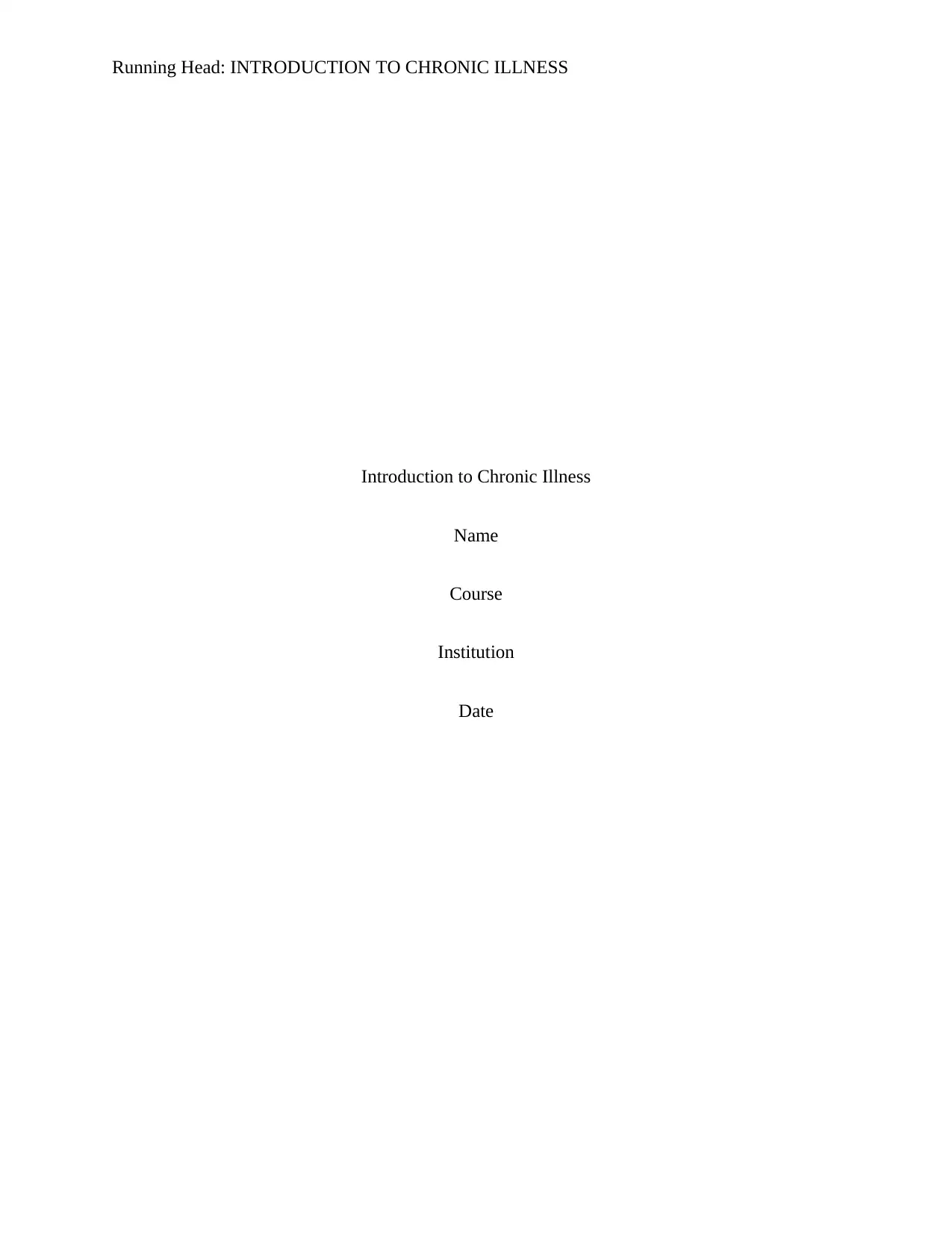
Running Head: INTRODUCTION TO CHRONIC ILLNESS
Introduction to Chronic Illness
Name
Course
Institution
Date
Introduction to Chronic Illness
Name
Course
Institution
Date
Paraphrase This Document
Need a fresh take? Get an instant paraphrase of this document with our AI Paraphraser
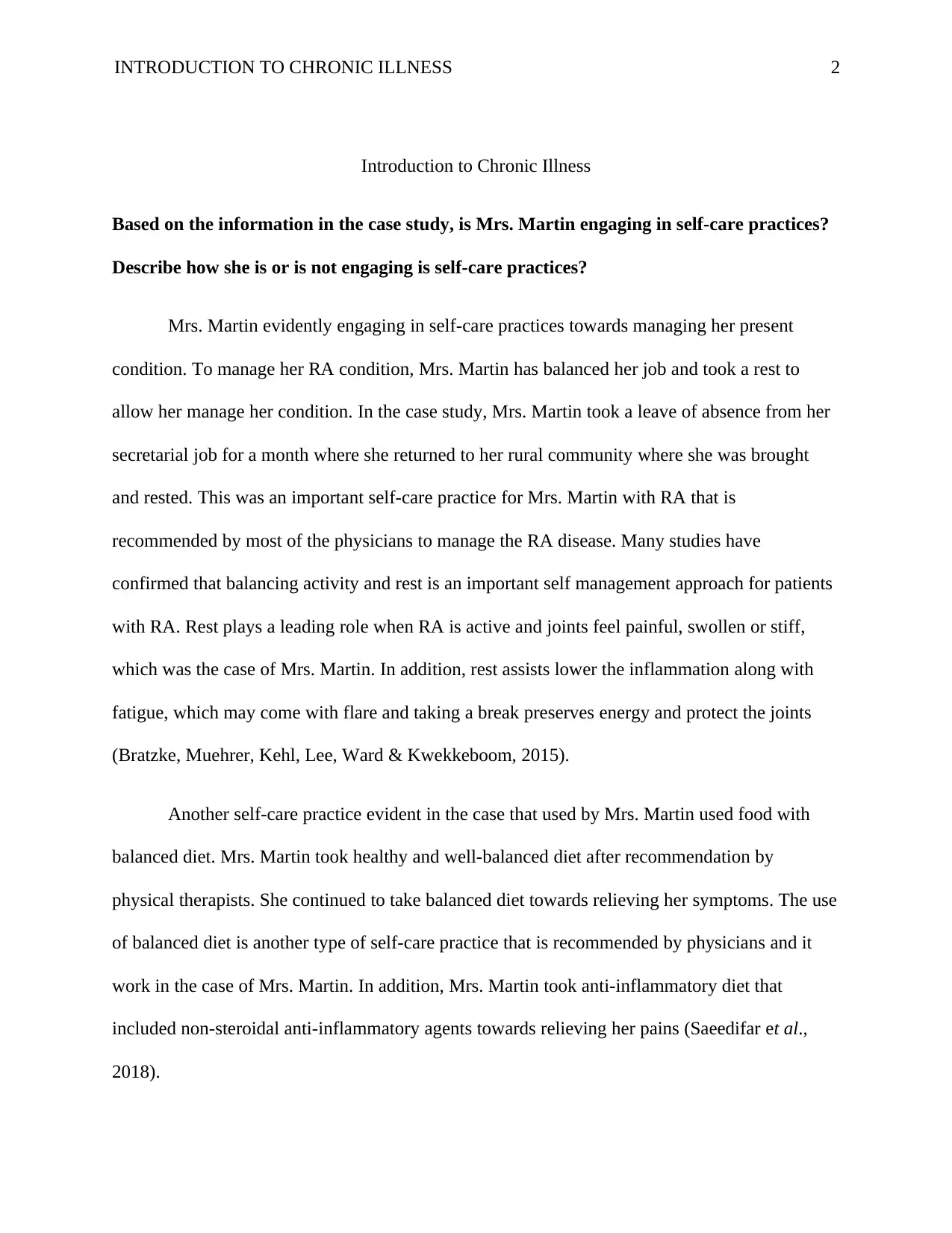
INTRODUCTION TO CHRONIC ILLNESS 2
Introduction to Chronic Illness
Based on the information in the case study, is Mrs. Martin engaging in self-care practices?
Describe how she is or is not engaging is self-care practices?
Mrs. Martin evidently engaging in self-care practices towards managing her present
condition. To manage her RA condition, Mrs. Martin has balanced her job and took a rest to
allow her manage her condition. In the case study, Mrs. Martin took a leave of absence from her
secretarial job for a month where she returned to her rural community where she was brought
and rested. This was an important self-care practice for Mrs. Martin with RA that is
recommended by most of the physicians to manage the RA disease. Many studies have
confirmed that balancing activity and rest is an important self management approach for patients
with RA. Rest plays a leading role when RA is active and joints feel painful, swollen or stiff,
which was the case of Mrs. Martin. In addition, rest assists lower the inflammation along with
fatigue, which may come with flare and taking a break preserves energy and protect the joints
(Bratzke, Muehrer, Kehl, Lee, Ward & Kwekkeboom, 2015).
Another self-care practice evident in the case that used by Mrs. Martin used food with
balanced diet. Mrs. Martin took healthy and well-balanced diet after recommendation by
physical therapists. She continued to take balanced diet towards relieving her symptoms. The use
of balanced diet is another type of self-care practice that is recommended by physicians and it
work in the case of Mrs. Martin. In addition, Mrs. Martin took anti-inflammatory diet that
included non-steroidal anti-inflammatory agents towards relieving her pains (Saeedifar et al.,
2018).
Introduction to Chronic Illness
Based on the information in the case study, is Mrs. Martin engaging in self-care practices?
Describe how she is or is not engaging is self-care practices?
Mrs. Martin evidently engaging in self-care practices towards managing her present
condition. To manage her RA condition, Mrs. Martin has balanced her job and took a rest to
allow her manage her condition. In the case study, Mrs. Martin took a leave of absence from her
secretarial job for a month where she returned to her rural community where she was brought
and rested. This was an important self-care practice for Mrs. Martin with RA that is
recommended by most of the physicians to manage the RA disease. Many studies have
confirmed that balancing activity and rest is an important self management approach for patients
with RA. Rest plays a leading role when RA is active and joints feel painful, swollen or stiff,
which was the case of Mrs. Martin. In addition, rest assists lower the inflammation along with
fatigue, which may come with flare and taking a break preserves energy and protect the joints
(Bratzke, Muehrer, Kehl, Lee, Ward & Kwekkeboom, 2015).
Another self-care practice evident in the case that used by Mrs. Martin used food with
balanced diet. Mrs. Martin took healthy and well-balanced diet after recommendation by
physical therapists. She continued to take balanced diet towards relieving her symptoms. The use
of balanced diet is another type of self-care practice that is recommended by physicians and it
work in the case of Mrs. Martin. In addition, Mrs. Martin took anti-inflammatory diet that
included non-steroidal anti-inflammatory agents towards relieving her pains (Saeedifar et al.,
2018).
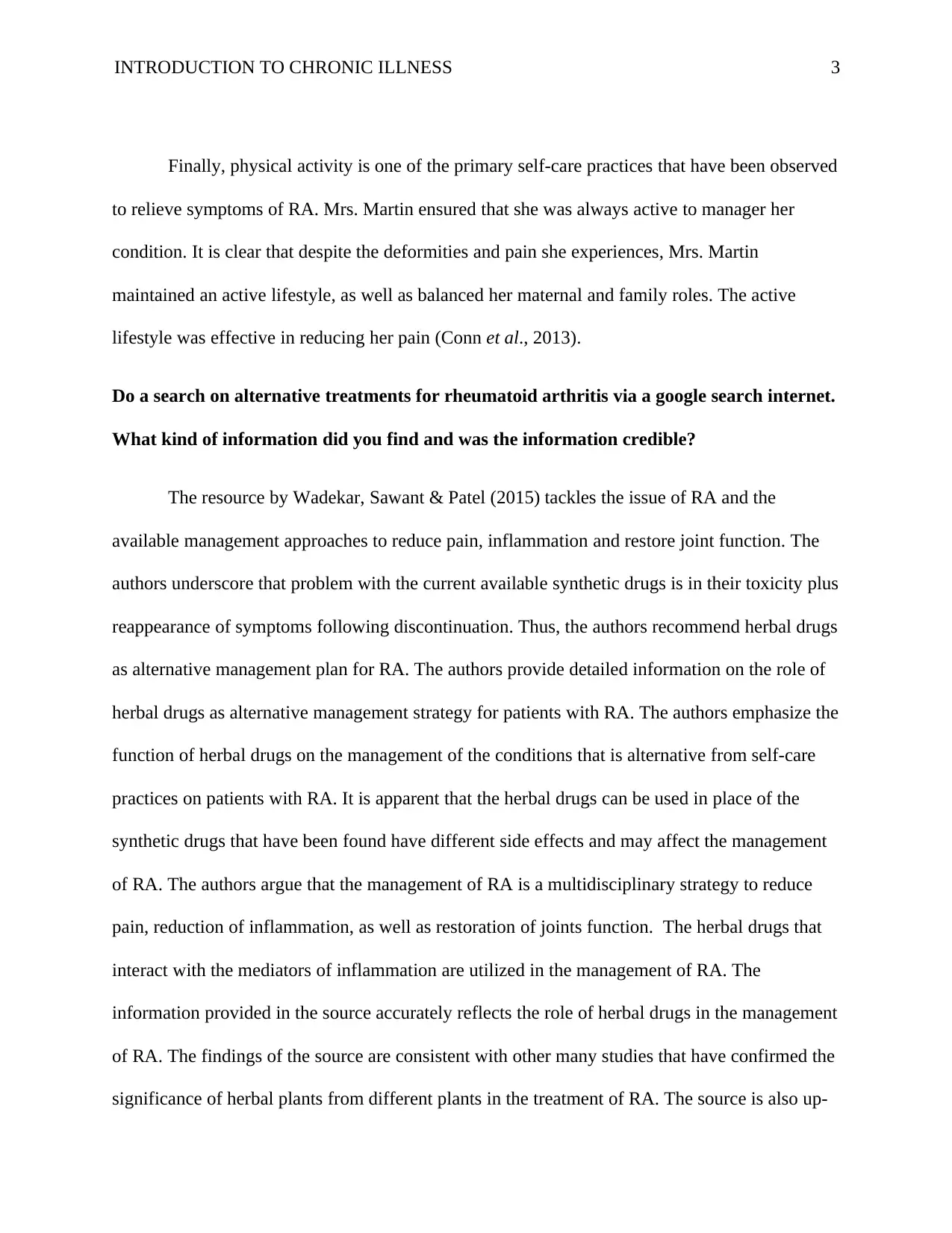
INTRODUCTION TO CHRONIC ILLNESS 3
Finally, physical activity is one of the primary self-care practices that have been observed
to relieve symptoms of RA. Mrs. Martin ensured that she was always active to manager her
condition. It is clear that despite the deformities and pain she experiences, Mrs. Martin
maintained an active lifestyle, as well as balanced her maternal and family roles. The active
lifestyle was effective in reducing her pain (Conn et al., 2013).
Do a search on alternative treatments for rheumatoid arthritis via a google search internet.
What kind of information did you find and was the information credible?
The resource by Wadekar, Sawant & Patel (2015) tackles the issue of RA and the
available management approaches to reduce pain, inflammation and restore joint function. The
authors underscore that problem with the current available synthetic drugs is in their toxicity plus
reappearance of symptoms following discontinuation. Thus, the authors recommend herbal drugs
as alternative management plan for RA. The authors provide detailed information on the role of
herbal drugs as alternative management strategy for patients with RA. The authors emphasize the
function of herbal drugs on the management of the conditions that is alternative from self-care
practices on patients with RA. It is apparent that the herbal drugs can be used in place of the
synthetic drugs that have been found have different side effects and may affect the management
of RA. The authors argue that the management of RA is a multidisciplinary strategy to reduce
pain, reduction of inflammation, as well as restoration of joints function. The herbal drugs that
interact with the mediators of inflammation are utilized in the management of RA. The
information provided in the source accurately reflects the role of herbal drugs in the management
of RA. The findings of the source are consistent with other many studies that have confirmed the
significance of herbal plants from different plants in the treatment of RA. The source is also up-
Finally, physical activity is one of the primary self-care practices that have been observed
to relieve symptoms of RA. Mrs. Martin ensured that she was always active to manager her
condition. It is clear that despite the deformities and pain she experiences, Mrs. Martin
maintained an active lifestyle, as well as balanced her maternal and family roles. The active
lifestyle was effective in reducing her pain (Conn et al., 2013).
Do a search on alternative treatments for rheumatoid arthritis via a google search internet.
What kind of information did you find and was the information credible?
The resource by Wadekar, Sawant & Patel (2015) tackles the issue of RA and the
available management approaches to reduce pain, inflammation and restore joint function. The
authors underscore that problem with the current available synthetic drugs is in their toxicity plus
reappearance of symptoms following discontinuation. Thus, the authors recommend herbal drugs
as alternative management plan for RA. The authors provide detailed information on the role of
herbal drugs as alternative management strategy for patients with RA. The authors emphasize the
function of herbal drugs on the management of the conditions that is alternative from self-care
practices on patients with RA. It is apparent that the herbal drugs can be used in place of the
synthetic drugs that have been found have different side effects and may affect the management
of RA. The authors argue that the management of RA is a multidisciplinary strategy to reduce
pain, reduction of inflammation, as well as restoration of joints function. The herbal drugs that
interact with the mediators of inflammation are utilized in the management of RA. The
information provided in the source accurately reflects the role of herbal drugs in the management
of RA. The findings of the source are consistent with other many studies that have confirmed the
significance of herbal plants from different plants in the treatment of RA. The source is also up-
⊘ This is a preview!⊘
Do you want full access?
Subscribe today to unlock all pages.

Trusted by 1+ million students worldwide
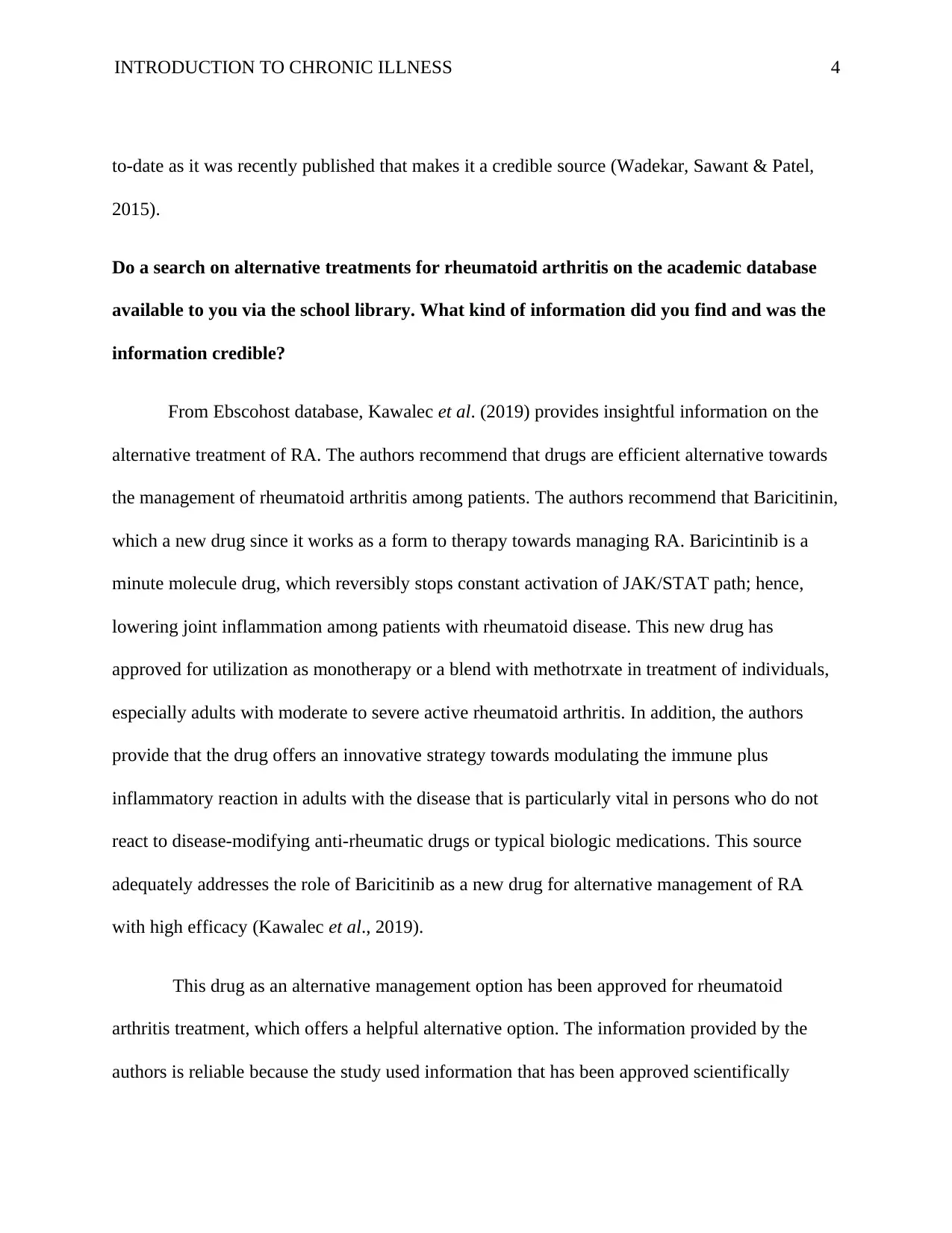
INTRODUCTION TO CHRONIC ILLNESS 4
to-date as it was recently published that makes it a credible source (Wadekar, Sawant & Patel,
2015).
Do a search on alternative treatments for rheumatoid arthritis on the academic database
available to you via the school library. What kind of information did you find and was the
information credible?
From Ebscohost database, Kawalec et al. (2019) provides insightful information on the
alternative treatment of RA. The authors recommend that drugs are efficient alternative towards
the management of rheumatoid arthritis among patients. The authors recommend that Baricitinin,
which a new drug since it works as a form to therapy towards managing RA. Baricintinib is a
minute molecule drug, which reversibly stops constant activation of JAK/STAT path; hence,
lowering joint inflammation among patients with rheumatoid disease. This new drug has
approved for utilization as monotherapy or a blend with methotrxate in treatment of individuals,
especially adults with moderate to severe active rheumatoid arthritis. In addition, the authors
provide that the drug offers an innovative strategy towards modulating the immune plus
inflammatory reaction in adults with the disease that is particularly vital in persons who do not
react to disease-modifying anti-rheumatic drugs or typical biologic medications. This source
adequately addresses the role of Baricitinib as a new drug for alternative management of RA
with high efficacy (Kawalec et al., 2019).
This drug as an alternative management option has been approved for rheumatoid
arthritis treatment, which offers a helpful alternative option. The information provided by the
authors is reliable because the study used information that has been approved scientifically
to-date as it was recently published that makes it a credible source (Wadekar, Sawant & Patel,
2015).
Do a search on alternative treatments for rheumatoid arthritis on the academic database
available to you via the school library. What kind of information did you find and was the
information credible?
From Ebscohost database, Kawalec et al. (2019) provides insightful information on the
alternative treatment of RA. The authors recommend that drugs are efficient alternative towards
the management of rheumatoid arthritis among patients. The authors recommend that Baricitinin,
which a new drug since it works as a form to therapy towards managing RA. Baricintinib is a
minute molecule drug, which reversibly stops constant activation of JAK/STAT path; hence,
lowering joint inflammation among patients with rheumatoid disease. This new drug has
approved for utilization as monotherapy or a blend with methotrxate in treatment of individuals,
especially adults with moderate to severe active rheumatoid arthritis. In addition, the authors
provide that the drug offers an innovative strategy towards modulating the immune plus
inflammatory reaction in adults with the disease that is particularly vital in persons who do not
react to disease-modifying anti-rheumatic drugs or typical biologic medications. This source
adequately addresses the role of Baricitinib as a new drug for alternative management of RA
with high efficacy (Kawalec et al., 2019).
This drug as an alternative management option has been approved for rheumatoid
arthritis treatment, which offers a helpful alternative option. The information provided by the
authors is reliable because the study used information that has been approved scientifically
Paraphrase This Document
Need a fresh take? Get an instant paraphrase of this document with our AI Paraphraser
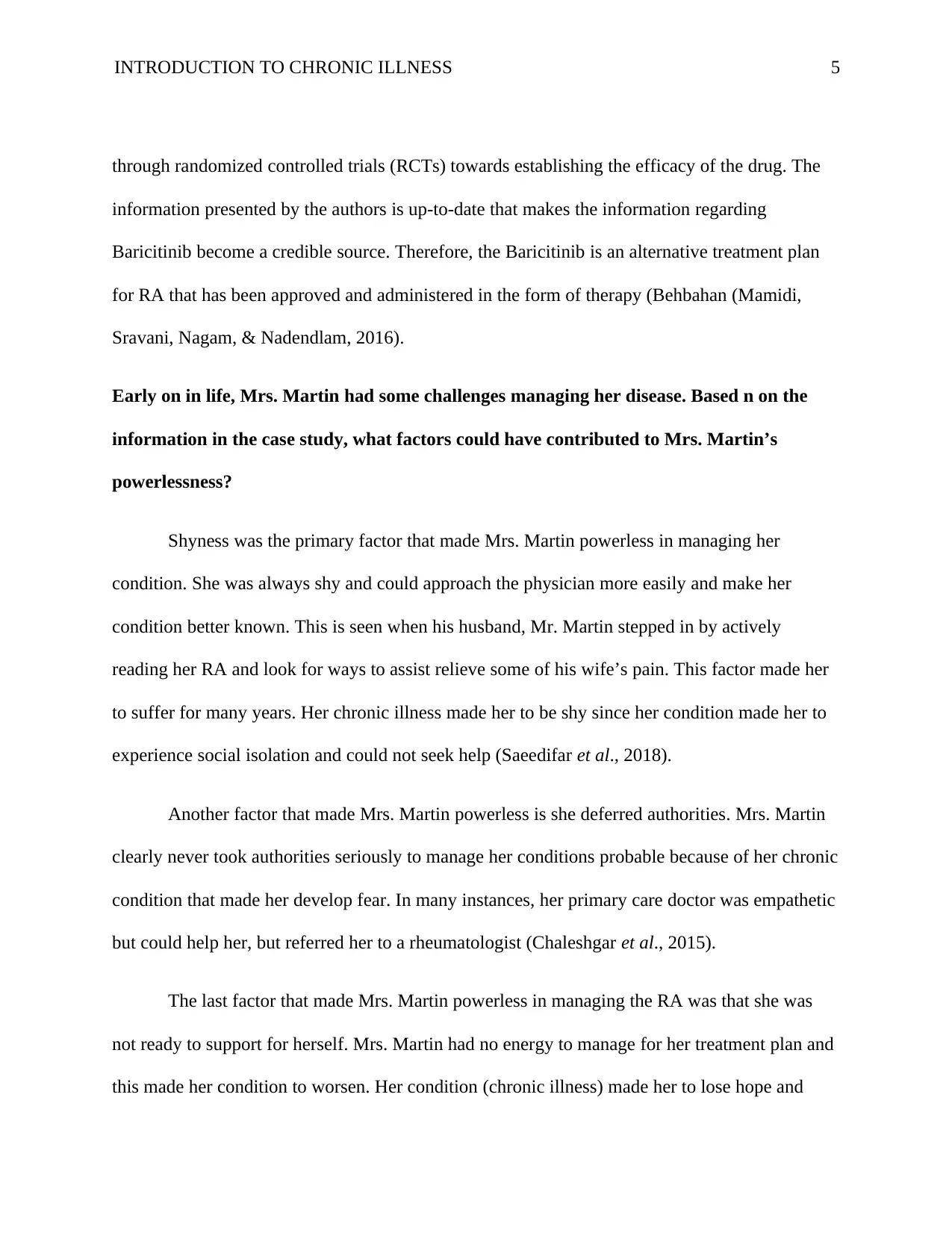
INTRODUCTION TO CHRONIC ILLNESS 5
through randomized controlled trials (RCTs) towards establishing the efficacy of the drug. The
information presented by the authors is up-to-date that makes the information regarding
Baricitinib become a credible source. Therefore, the Baricitinib is an alternative treatment plan
for RA that has been approved and administered in the form of therapy (Behbahan (Mamidi,
Sravani, Nagam, & Nadendlam, 2016).
Early on in life, Mrs. Martin had some challenges managing her disease. Based n on the
information in the case study, what factors could have contributed to Mrs. Martin’s
powerlessness?
Shyness was the primary factor that made Mrs. Martin powerless in managing her
condition. She was always shy and could approach the physician more easily and make her
condition better known. This is seen when his husband, Mr. Martin stepped in by actively
reading her RA and look for ways to assist relieve some of his wife’s pain. This factor made her
to suffer for many years. Her chronic illness made her to be shy since her condition made her to
experience social isolation and could not seek help (Saeedifar et al., 2018).
Another factor that made Mrs. Martin powerless is she deferred authorities. Mrs. Martin
clearly never took authorities seriously to manage her conditions probable because of her chronic
condition that made her develop fear. In many instances, her primary care doctor was empathetic
but could help her, but referred her to a rheumatologist (Chaleshgar et al., 2015).
The last factor that made Mrs. Martin powerless in managing the RA was that she was
not ready to support for herself. Mrs. Martin had no energy to manage for her treatment plan and
this made her condition to worsen. Her condition (chronic illness) made her to lose hope and
through randomized controlled trials (RCTs) towards establishing the efficacy of the drug. The
information presented by the authors is up-to-date that makes the information regarding
Baricitinib become a credible source. Therefore, the Baricitinib is an alternative treatment plan
for RA that has been approved and administered in the form of therapy (Behbahan (Mamidi,
Sravani, Nagam, & Nadendlam, 2016).
Early on in life, Mrs. Martin had some challenges managing her disease. Based n on the
information in the case study, what factors could have contributed to Mrs. Martin’s
powerlessness?
Shyness was the primary factor that made Mrs. Martin powerless in managing her
condition. She was always shy and could approach the physician more easily and make her
condition better known. This is seen when his husband, Mr. Martin stepped in by actively
reading her RA and look for ways to assist relieve some of his wife’s pain. This factor made her
to suffer for many years. Her chronic illness made her to be shy since her condition made her to
experience social isolation and could not seek help (Saeedifar et al., 2018).
Another factor that made Mrs. Martin powerless is she deferred authorities. Mrs. Martin
clearly never took authorities seriously to manage her conditions probable because of her chronic
condition that made her develop fear. In many instances, her primary care doctor was empathetic
but could help her, but referred her to a rheumatologist (Chaleshgar et al., 2015).
The last factor that made Mrs. Martin powerless in managing the RA was that she was
not ready to support for herself. Mrs. Martin had no energy to manage for her treatment plan and
this made her condition to worsen. Her condition (chronic illness) made her to lose hope and
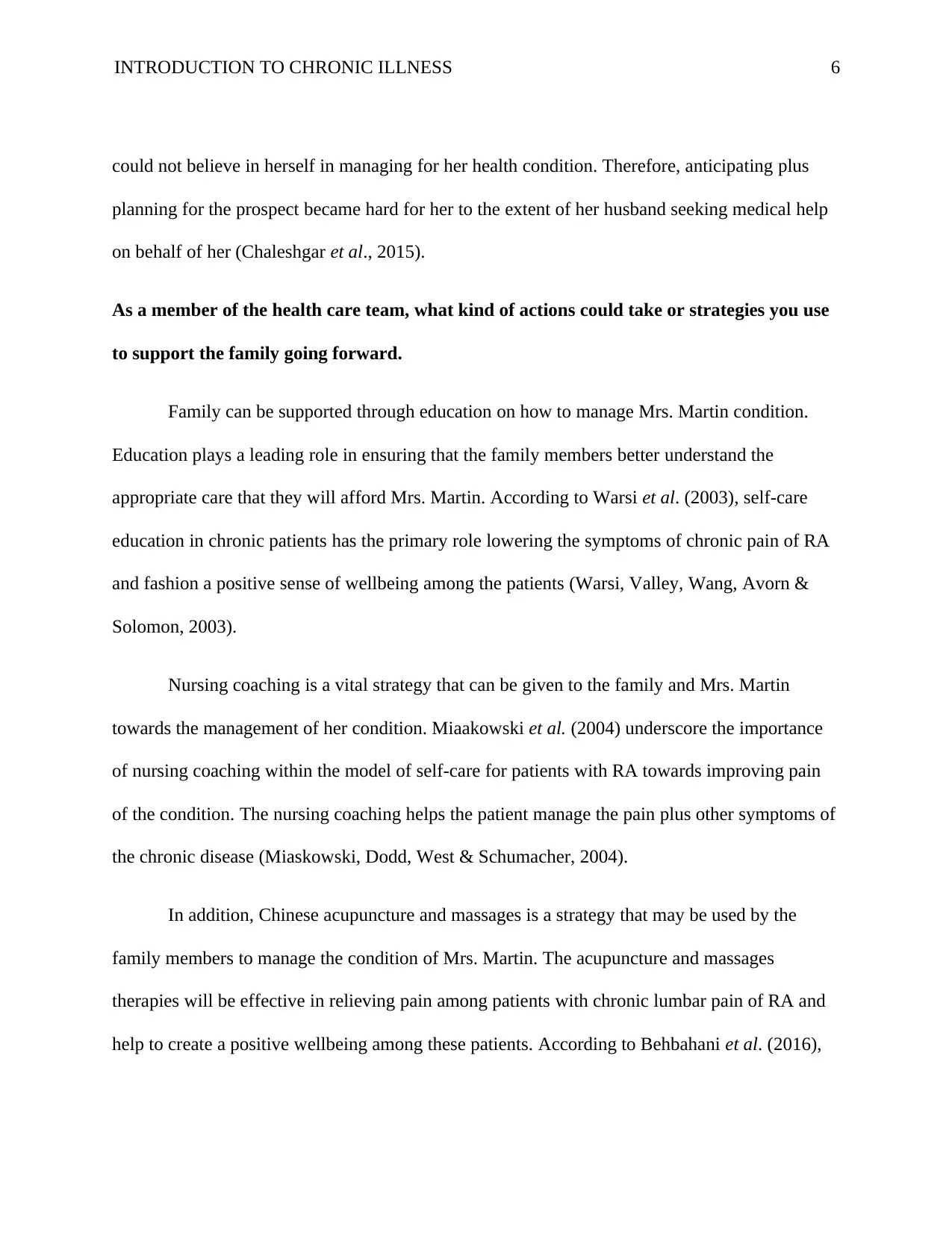
INTRODUCTION TO CHRONIC ILLNESS 6
could not believe in herself in managing for her health condition. Therefore, anticipating plus
planning for the prospect became hard for her to the extent of her husband seeking medical help
on behalf of her (Chaleshgar et al., 2015).
As a member of the health care team, what kind of actions could take or strategies you use
to support the family going forward.
Family can be supported through education on how to manage Mrs. Martin condition.
Education plays a leading role in ensuring that the family members better understand the
appropriate care that they will afford Mrs. Martin. According to Warsi et al. (2003), self-care
education in chronic patients has the primary role lowering the symptoms of chronic pain of RA
and fashion a positive sense of wellbeing among the patients (Warsi, Valley, Wang, Avorn &
Solomon, 2003).
Nursing coaching is a vital strategy that can be given to the family and Mrs. Martin
towards the management of her condition. Miaakowski et al. (2004) underscore the importance
of nursing coaching within the model of self-care for patients with RA towards improving pain
of the condition. The nursing coaching helps the patient manage the pain plus other symptoms of
the chronic disease (Miaskowski, Dodd, West & Schumacher, 2004).
In addition, Chinese acupuncture and massages is a strategy that may be used by the
family members to manage the condition of Mrs. Martin. The acupuncture and massages
therapies will be effective in relieving pain among patients with chronic lumbar pain of RA and
help to create a positive wellbeing among these patients. According to Behbahani et al. (2016),
could not believe in herself in managing for her health condition. Therefore, anticipating plus
planning for the prospect became hard for her to the extent of her husband seeking medical help
on behalf of her (Chaleshgar et al., 2015).
As a member of the health care team, what kind of actions could take or strategies you use
to support the family going forward.
Family can be supported through education on how to manage Mrs. Martin condition.
Education plays a leading role in ensuring that the family members better understand the
appropriate care that they will afford Mrs. Martin. According to Warsi et al. (2003), self-care
education in chronic patients has the primary role lowering the symptoms of chronic pain of RA
and fashion a positive sense of wellbeing among the patients (Warsi, Valley, Wang, Avorn &
Solomon, 2003).
Nursing coaching is a vital strategy that can be given to the family and Mrs. Martin
towards the management of her condition. Miaakowski et al. (2004) underscore the importance
of nursing coaching within the model of self-care for patients with RA towards improving pain
of the condition. The nursing coaching helps the patient manage the pain plus other symptoms of
the chronic disease (Miaskowski, Dodd, West & Schumacher, 2004).
In addition, Chinese acupuncture and massages is a strategy that may be used by the
family members to manage the condition of Mrs. Martin. The acupuncture and massages
therapies will be effective in relieving pain among patients with chronic lumbar pain of RA and
help to create a positive wellbeing among these patients. According to Behbahani et al. (2016),
⊘ This is a preview!⊘
Do you want full access?
Subscribe today to unlock all pages.

Trusted by 1+ million students worldwide
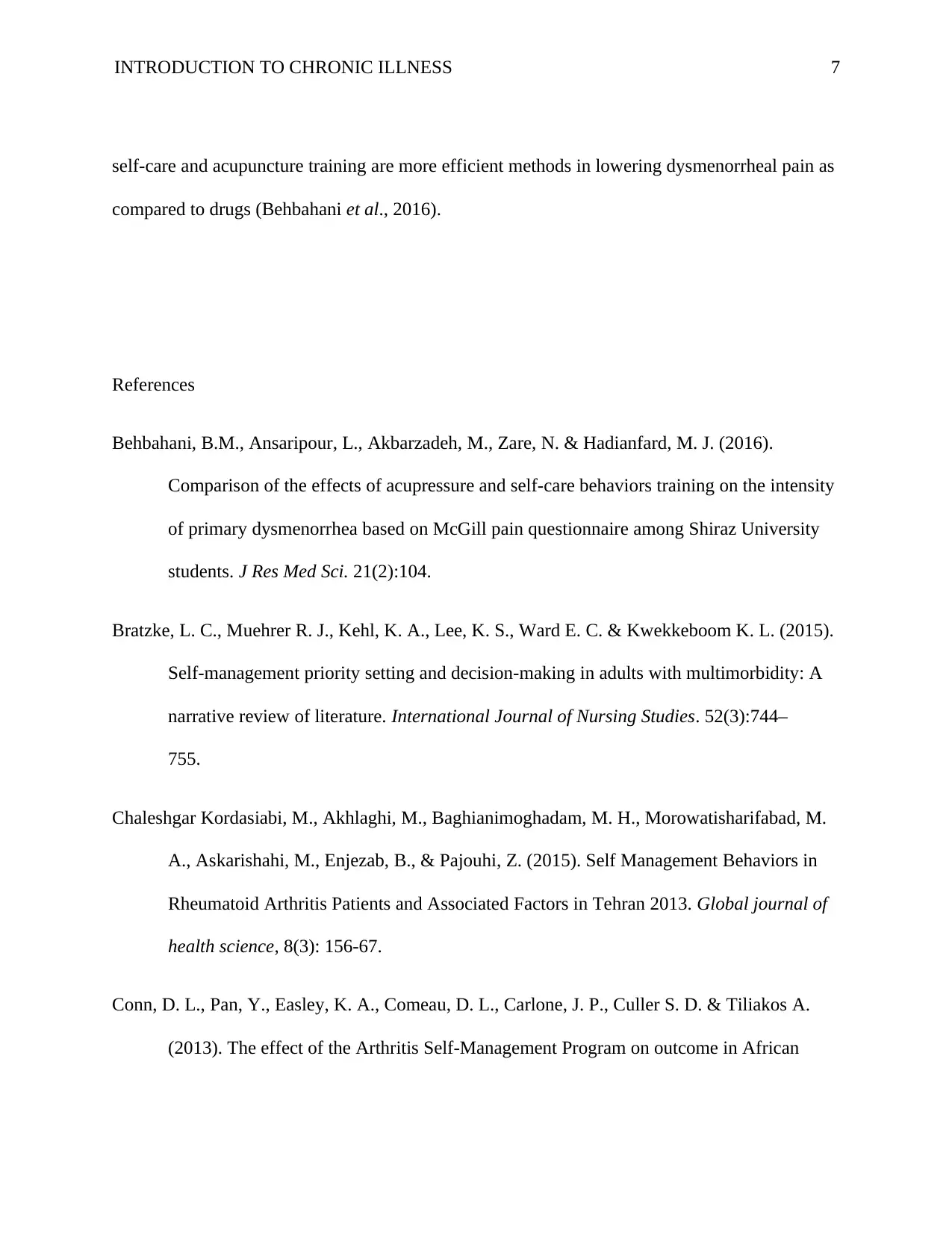
INTRODUCTION TO CHRONIC ILLNESS 7
self-care and acupuncture training are more efficient methods in lowering dysmenorrheal pain as
compared to drugs (Behbahani et al., 2016).
References
Behbahani, B.M., Ansaripour, L., Akbarzadeh, M., Zare, N. & Hadianfard, M. J. (2016).
Comparison of the effects of acupressure and self-care behaviors training on the intensity
of primary dysmenorrhea based on McGill pain questionnaire among Shiraz University
students. J Res Med Sci. 21(2):104.
Bratzke, L. C., Muehrer R. J., Kehl, K. A., Lee, K. S., Ward E. C. & Kwekkeboom K. L. (2015).
Self-management priority setting and decision-making in adults with multimorbidity: A
narrative review of literature. International Journal of Nursing Studies. 52(3):744–
755.
Chaleshgar Kordasiabi, M., Akhlaghi, M., Baghianimoghadam, M. H., Morowatisharifabad, M.
A., Askarishahi, M., Enjezab, B., & Pajouhi, Z. (2015). Self Management Behaviors in
Rheumatoid Arthritis Patients and Associated Factors in Tehran 2013. Global journal of
health science, 8(3): 156-67.
Conn, D. L., Pan, Y., Easley, K. A., Comeau, D. L., Carlone, J. P., Culler S. D. & Tiliakos A.
(2013). The effect of the Arthritis Self-Management Program on outcome in African
self-care and acupuncture training are more efficient methods in lowering dysmenorrheal pain as
compared to drugs (Behbahani et al., 2016).
References
Behbahani, B.M., Ansaripour, L., Akbarzadeh, M., Zare, N. & Hadianfard, M. J. (2016).
Comparison of the effects of acupressure and self-care behaviors training on the intensity
of primary dysmenorrhea based on McGill pain questionnaire among Shiraz University
students. J Res Med Sci. 21(2):104.
Bratzke, L. C., Muehrer R. J., Kehl, K. A., Lee, K. S., Ward E. C. & Kwekkeboom K. L. (2015).
Self-management priority setting and decision-making in adults with multimorbidity: A
narrative review of literature. International Journal of Nursing Studies. 52(3):744–
755.
Chaleshgar Kordasiabi, M., Akhlaghi, M., Baghianimoghadam, M. H., Morowatisharifabad, M.
A., Askarishahi, M., Enjezab, B., & Pajouhi, Z. (2015). Self Management Behaviors in
Rheumatoid Arthritis Patients and Associated Factors in Tehran 2013. Global journal of
health science, 8(3): 156-67.
Conn, D. L., Pan, Y., Easley, K. A., Comeau, D. L., Carlone, J. P., Culler S. D. & Tiliakos A.
(2013). The effect of the Arthritis Self-Management Program on outcome in African
Paraphrase This Document
Need a fresh take? Get an instant paraphrase of this document with our AI Paraphraser
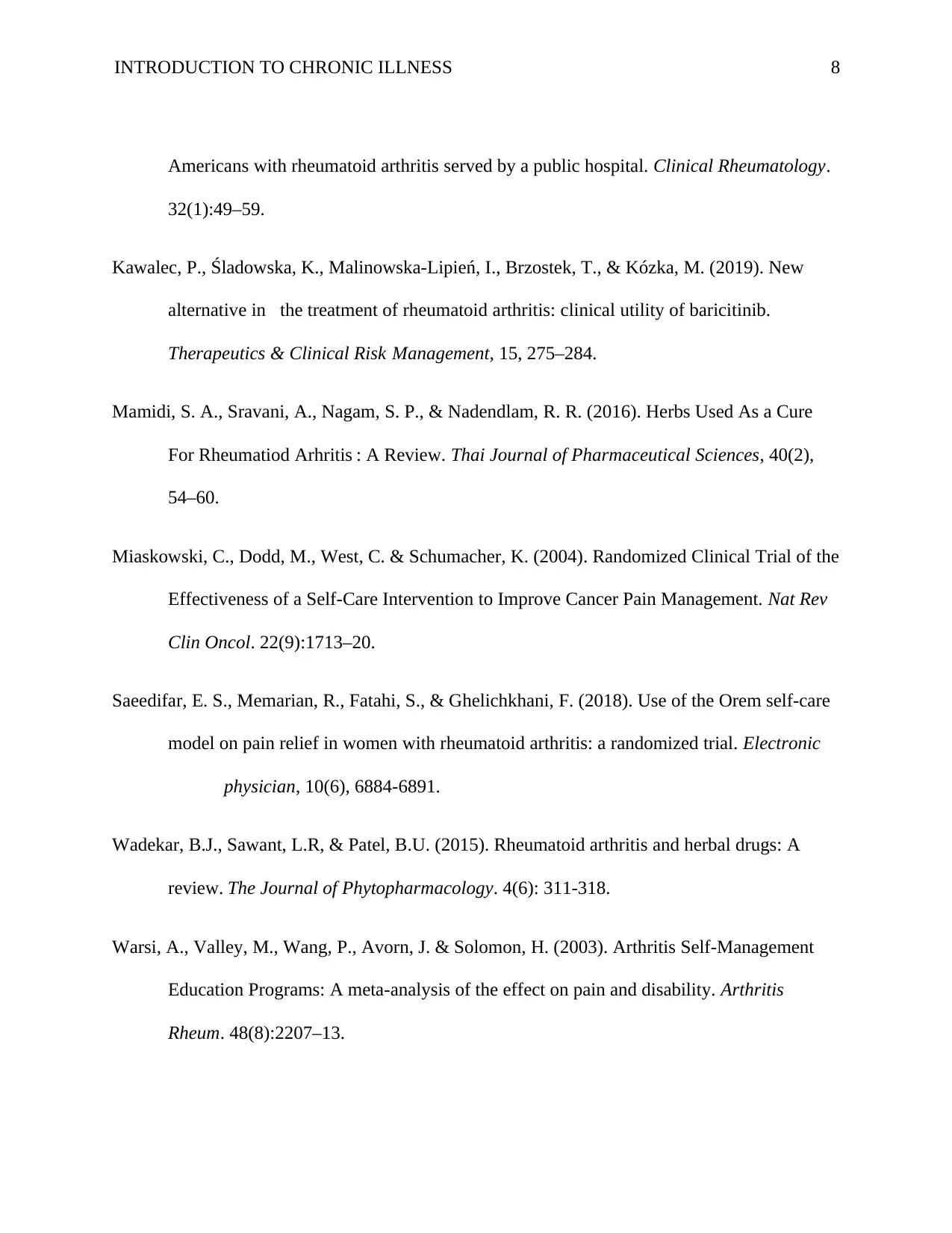
INTRODUCTION TO CHRONIC ILLNESS 8
Americans with rheumatoid arthritis served by a public hospital. Clinical Rheumatology.
32(1):49–59.
Kawalec, P., Śladowska, K., Malinowska-Lipień, I., Brzostek, T., & Kózka, M. (2019). New
alternative in the treatment of rheumatoid arthritis: clinical utility of baricitinib.
Therapeutics & Clinical Risk Management, 15, 275–284.
Mamidi, S. A., Sravani, A., Nagam, S. P., & Nadendlam, R. R. (2016). Herbs Used As a Cure
For Rheumatiod Arhritis : A Review. Thai Journal of Pharmaceutical Sciences, 40(2),
54–60.
Miaskowski, C., Dodd, M., West, C. & Schumacher, K. (2004). Randomized Clinical Trial of the
Effectiveness of a Self-Care Intervention to Improve Cancer Pain Management. Nat Rev
Clin Oncol. 22(9):1713–20.
Saeedifar, E. S., Memarian, R., Fatahi, S., & Ghelichkhani, F. (2018). Use of the Orem self-care
model on pain relief in women with rheumatoid arthritis: a randomized trial. Electronic
physician, 10(6), 6884-6891.
Wadekar, B.J., Sawant, L.R, & Patel, B.U. (2015). Rheumatoid arthritis and herbal drugs: A
review. The Journal of Phytopharmacology. 4(6): 311-318.
Warsi, A., Valley, M., Wang, P., Avorn, J. & Solomon, H. (2003). Arthritis Self-Management
Education Programs: A meta-analysis of the effect on pain and disability. Arthritis
Rheum. 48(8):2207–13.
Americans with rheumatoid arthritis served by a public hospital. Clinical Rheumatology.
32(1):49–59.
Kawalec, P., Śladowska, K., Malinowska-Lipień, I., Brzostek, T., & Kózka, M. (2019). New
alternative in the treatment of rheumatoid arthritis: clinical utility of baricitinib.
Therapeutics & Clinical Risk Management, 15, 275–284.
Mamidi, S. A., Sravani, A., Nagam, S. P., & Nadendlam, R. R. (2016). Herbs Used As a Cure
For Rheumatiod Arhritis : A Review. Thai Journal of Pharmaceutical Sciences, 40(2),
54–60.
Miaskowski, C., Dodd, M., West, C. & Schumacher, K. (2004). Randomized Clinical Trial of the
Effectiveness of a Self-Care Intervention to Improve Cancer Pain Management. Nat Rev
Clin Oncol. 22(9):1713–20.
Saeedifar, E. S., Memarian, R., Fatahi, S., & Ghelichkhani, F. (2018). Use of the Orem self-care
model on pain relief in women with rheumatoid arthritis: a randomized trial. Electronic
physician, 10(6), 6884-6891.
Wadekar, B.J., Sawant, L.R, & Patel, B.U. (2015). Rheumatoid arthritis and herbal drugs: A
review. The Journal of Phytopharmacology. 4(6): 311-318.
Warsi, A., Valley, M., Wang, P., Avorn, J. & Solomon, H. (2003). Arthritis Self-Management
Education Programs: A meta-analysis of the effect on pain and disability. Arthritis
Rheum. 48(8):2207–13.
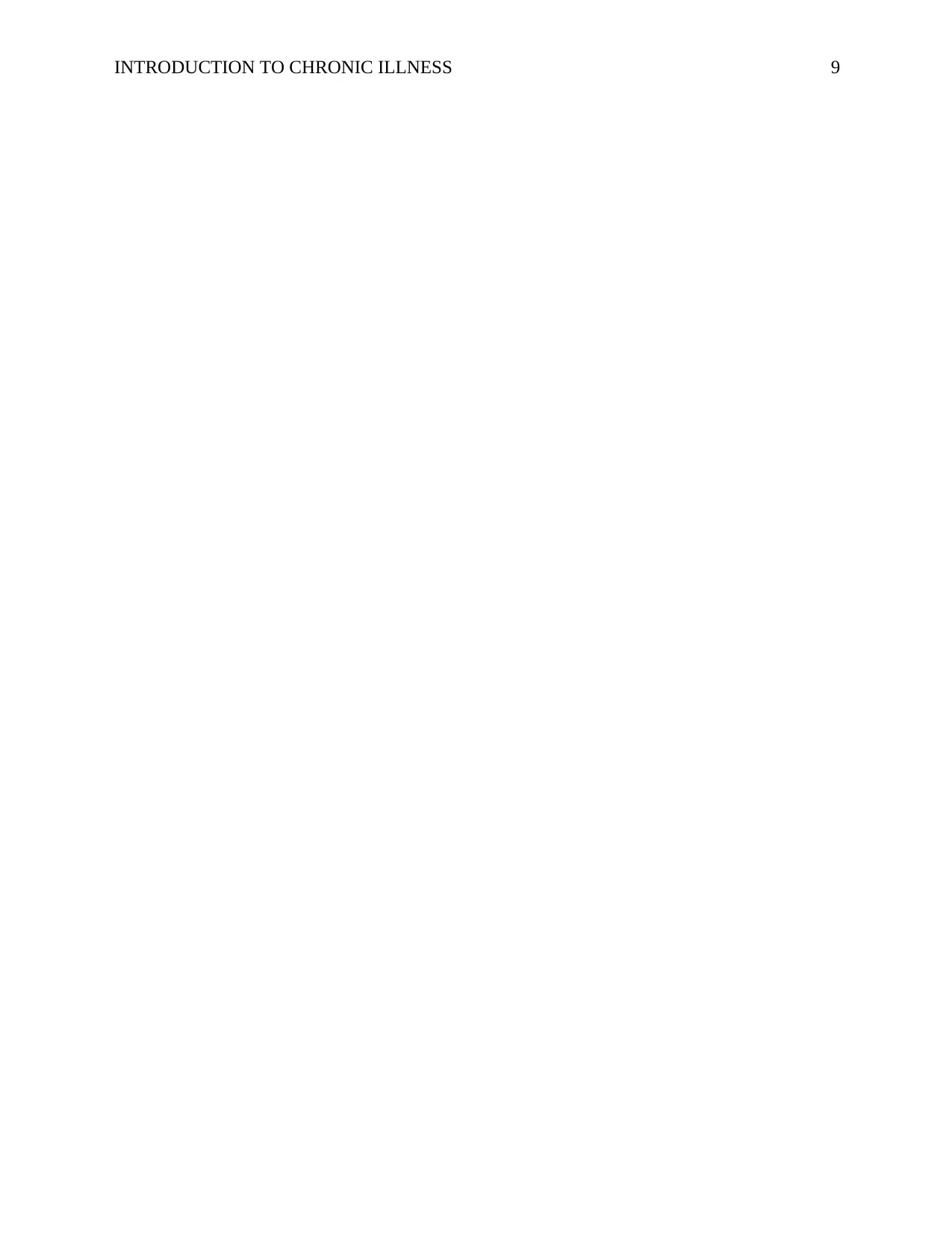
INTRODUCTION TO CHRONIC ILLNESS 9
⊘ This is a preview!⊘
Do you want full access?
Subscribe today to unlock all pages.

Trusted by 1+ million students worldwide
1 out of 9
Related Documents
Your All-in-One AI-Powered Toolkit for Academic Success.
+13062052269
info@desklib.com
Available 24*7 on WhatsApp / Email
![[object Object]](/_next/static/media/star-bottom.7253800d.svg)
Unlock your academic potential
Copyright © 2020–2025 A2Z Services. All Rights Reserved. Developed and managed by ZUCOL.





